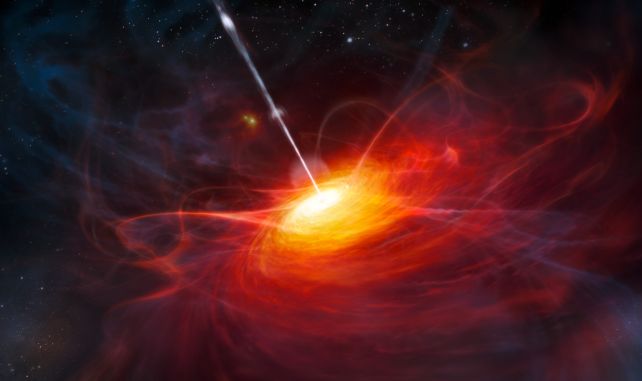For the first time, starlight has been seen in galaxies burning brightly in the fury of feeding black holes in the first billion years of the Universe’s existence.
It makes sense that these active supermassive black holes – known as quasars – would have galaxies around them. But at such vast distances, any starlight within them was previously impossible to detect, leaving astronomers wondering how such massive objects formed and grew in such a short period of time.
Now, with combined data from the Subaru Telescope in Hawaii and the James Webb Space Telescope, a large international team has been able to examine two quasar galaxies in the early Universe to learn more about this mysterious period in everyone’s history. .
The research was led by astrophysicists Xuheng Ding and John Silverman of the Kavli Institute for the Physics and Mathematics of the Universe (Kavli IPMU) in Japan and Masafusa Onoue of the Kavli Institute for Astronomy and Astrophysics in China.
“This is the first time we have seen host galaxies from the young age of the Universe. This is only possible thanks to the deep JWST images, which allow us to model and subtract the light from the quasar to reveal the host galaxy, ” explained astronomer Chien-Hsiu Lee of the WM Keck Observatory.
“We’ve seen quasars from this age before, but they were so bright that it was impossible to subtract their brightness to reveal the host galaxy.”

Black holes themselves do not emit any light that we can currently see. They are famous for it, in fact.
But an active black hole is a slightly different matter. Well, not the black hole; it was still almost as dark. It is what is happening in the space around it. An active black hole is one that has enough material around it to feed on. That material orbits the black hole, heated to millions of degrees by friction and gravity so it radiates across the electromagnetic spectrum.
There is so much material orbiting a quasar that it positively burns through eons of space-time. That’s how we see them glowing at Cosmic Dawn, the period spanning the first billion years after the Big Bang. Even there, they’re still pretty vague; you’ll never see a Cosmic Dawn quasar with the naked eye or a backyard telescope, but in recent years our powerful telescopes have been finding them in increasing numbers.
This raises all sorts of questions, such as: how do we get a supermassive black hole so massive, after the Big Bang? What is their galactic environment? We’re still a little lost on the first question, but we’re finally getting answers to the second.
The two quasar galaxies in question are called HSC J2236+0032 and HSC J2255+0251, and we observe them about 860 million years after the Big Bang. They were found in a survey taken with Subaru, where JWST was called to study them in more detail.
The supermassive black holes at the centers of these two quasar galaxies are 1.4 billion and 200 million times the mass of the Sun, respectively. This allows constraints to be placed on the amount of light produced by black hole activity, as there is a limit to the rate at which a black hole can consume.
The researchers subtracted this light from the JWST observations, which left them with the light generated by the host galaxies: the light of their stars, which shine.
Even more than that, though, the brightness of the galaxies allowed the researchers to calculate the mass of the galaxies – 130 billion and 30 billion solar masses, respectively.
This is important because it tells us something we don’t know about the early galaxies of the Universe. The masses of supermassive black holes and their galaxies in the nearby Universe are linked. If you know the mass of a black hole, the mass of a galaxy around it can be predicted, and vice versa, even for small galaxies.
frameborder=”0″ allow=”accelerometer; auto-play; clipboard-write; encrypted media; gyroscope; picture-in-picture; web-share” allowfullscreen>
We are not sure why this is, whether it is a property of black holes that limits the growth of galaxies to a certain point, or whether galaxies and supermassive black holes grow together, but the search for black holes in the early Universe may give us some clues.
Both J2236+0032 and J2255+0251 are consistent in this mass ratio between the supermassive black hole and its galaxy. This suggests that this relationship was already in place when the first supermassive black hole was born. And it gives astronomers a new datapoint to work with when modeling the early evolution of the Universe to understand how things happened during the Cosmic Dawn.
Whether or not this is true for all early Universe galaxies remains to be investigated. The two galaxies aren’t a very large sample, so the researchers will be coming back for more. They have booked more observing time with JWST, and hope to learn more about how the first galaxies formed.
“Continued JWST observations will provide us with a significantly larger sample,” they wrote in their paper, “allowing us to better constrain models for the mutual evolution of black holes and stellar populations in the galaxies.”
The research was published in Nature.
#Time #Starlight #Quasar #Galaxies #Detected #Dawn #Universe














Add Comment